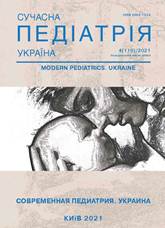State of iodine supply of children with chronic somatic diseases
DOI:
https://doi.org/10.15574/SP.2021.116.13Keywords:
iodine deficiency, school-age children, the level of iodine excretionAbstract
One of the most common conditions resulting from micronutrient deficiency is iodine deficiency.
Purpose — to evaluate the current state of iodine supply in schoolchildren living in the North-Eastern region of Ukraine, including children with digestive diseases and inflammatory joint diseases.
Materials and methods. Target group: 86 people (11.8±2.71 years), which included patients with digestive diseases (DD) (26.7%) and juvenile idiopathic arthritis (JIA) (60.5%). Methods: dietary iodine intake evaluation by urinary iodine concentration (Sandell–Kolthoff reaction), followed by calculation of the median.
Results. Median urinary iodine excretion was at the lower normal range and amounted to 104.98 μg/l [QR: 59.8; 180.1] in the examined children. Only 51.2% of children had adequate iodine provision; mild iodine deficiency (ID) was diagnosed in 29.1% (Ме=81,91μg/l [QR: 64.26; 90.58]); moderate — 17.4% (Ме=36,19 μg/l [QR: 33.54; 42.24]); severe — in 2.3% of the surveyed (Ме 14,02 μg/l [QR: 12.34; 15.70]). The median urinary iodine excretion in children with somatic diseases was significantly lower than in children of the control group and amounted to 97.26 μg/l [QR 53.7; 148.3] versus 183.71 μg/l [QR 104.4; 287.4], (p=0.003).
Conclusions. School-age children have a high incidence of iodine deficiency (51.2%). Often encountered in childhood diseases (DD and JIA) are accompanied by insufficiency of iodine supply.
The research was carried out in accordance with the principles of the Helsinki declaration. The study protocol was approved by the Local Ethics Committee of all participating institution. The informed consent of the patient was obtained for conducting the studies.
No conflict of interest was declared by the author.
References
Biondi B, Cooper DS. (2008). The clinical significance of subclinical thyroid dysfunction. Endocr Rev. 29: 76-131. https://doi.org/10.1210/er.2006-0043; PMid:17991805
Cellini M, Santaguida MG, Virili C, Capriello S, Brusca N, Gargano L, Centanni M. (2017). Hashimoto's Thyroiditis and Autoimmune Gastritis. 8: 92. https://doi.org/10.3389/fendo.2017.00092; PMid:28491051 PMCid:PMC5405068
Cerbone M, Bravaccio C, Capalbo D, Polizzi M, Wasniewska M, Cioffi D, Improda N et al. (2011). Linear growth and intellectual outcome in children with longterm idiopathic subclinical hypothyroidism. Eur J Endocrinol. 164: 591-597. https://doi.org/10.1530/EJE-10-0979; PMid:21292920
Ergur AT, Taner Y, Ata E, Melek E. (2012). Neurocognitive functions in children and adolescents with subclinical hypothyroidism. J Clin Res Pediatr Endocrinol. 4: 21-24. https://doi.org/10.4274/Jcrpe.497; PMid:22394701 PMCid:PMC3316458
Golkowski F, Szybinski Z, Rachtan J, Sokolowski A, Buziak-Bereza M, Trofimiuk M, Hubalewska-Dydejczyk A et al. (2007). Iodine prophylaxis - the protective factor against stomach cancer in iodine deficient areas. Eur J Nutr. 46: 251-256. https://doi.org/10.1007/s00394-007-0657-8; PMid:17497074
Jonklaas J, Bianco AC, Bauer AJ, Burman KD, Cappola AR, Celi FS, Cooper DS et al. (2014). Guidelines for the treatment of hypothyroidism: prepared by the american thyroid association task force on thyroid hormone replacement. Thyroid. 24 (12): 1670-1751. https://doi.org/10.1089/thy.2014.0028; PMid:25266247 PMCid:PMC4267409
Mamenko MY. (2017). Prevention of iodine deficiency disorders: what should know and can do a pediatrician and general practitioner (Clinical practice guideline). Sovremennaya pediatriya. 2 (82): 8-16. https://doi.org/10.15574/SP.2017.82.8
MOZ Ukrainy. (2012). Pro zatverdzhennia unifikovanykh klinichnykh protokoliv medychnoi dopomohy ditiam, khvorym na yuvenilnyi artryt. Order of the Ministry of Health of Ukraine No. 832 dated October 22. URL: https://zakon.rada.gov.ua/rada/show/v0832282-12#Text.
MOZ Ukrainy. (2013). Pro zatverdzhennia unifikovanykh klinichnykh protokoliv medychnoi dopomohy ditiam iz zakhvoriuvanniamy orhaniv travlennia. Order of the Ministry of Health of Ukraine No. 59 dated January 29. URL: https://zakon.rada.gov.ua/rada/show/v0059282-13#Text.
Nicola JP, Basquin C, Portulano C, Reyna-Neyra A, Paroder M, Carrasco N. (2009). The Na+/I- symporter mediates active iodide uptake in the intestine. Am J Physiol Cell Physiol. 296 (4): C654-C662. https://doi.org/10.1152/ajpcell.00509.2008; PMid:19052257 PMCid:PMC2670652
Pesce L, Kopp P. (2014). Iodide transport: implications for health and disease. Int J Pediatr Endocrinol: 8. https://doi.org/10.1186/1687-9856-2014-8; PMid:25009573 PMCid:PMC4089555
Rapa A, Monzani A, Moia S, Vivenza D, Bellone S, Petri A, Teofoli F et al. (2009). Subclinical hypothyroidism in children and adolescents: a wide range of clinical, biochemical, and genetic factors involved. J Clin Endocrinol Metab. 94: 2414-2420. https://doi.org/10.1210/jc.2009-0375; PMid:19417038
Shypko AF. (2014). The state of health of children in the Kharkiv region. Medicine today and tomorrow. 4 (65): 75-79. URL: http://nbuv.gov.ua/UJRN/Msiz_2014_4_15.
Tabaeizadeh M, Haghpanah V, Abbasali K, Gholamreza S, Khadijeh A, Heshmat R, Rohani D et al. (2013). Goiter frequency is more strongly associated with gastric adenocarcinoma than urine iodine level. J Gastric Cancer. 13 (2): 106-110. https://doi.org/10.5230/jgc.2013.13.2.106; PMid:23844325 PMCid:PMC3705130
Venturi S, Venturi A, Cimini D, Arduini C, Venturi M, Guidi A. (1993). A new hypothesis: iodine and gastric cancer. Eur J Cancer Prev. 2: 17-23. URL: https://pubmed.ncbi.nlm.nih.gov/8428171. https://doi.org/10.1097/00008469-199301000-00004; PMid:8428171
Venturi S, Grossi L, Marra GA, Venturi A, Venturi M. (2003). Iodine, Helicobacter pylori, stomach cancer and evolution. Europ. EpiMarker. 7: 1-7.
World Heals Organization. (2020). Micronutrient deficiencies. URL: https://www.who.int/nutrition/topics/idd/en.
Downloads
Published
Issue
Section
License
Copyright (c) 2021 Modern Pediatrics. Ukraine

This work is licensed under a Creative Commons Attribution-NonCommercial 4.0 International License.
The policy of the Journal “MODERN PEDIATRICS. UKRAINE” is compatible with the vast majority of funders' of open access and self-archiving policies. The journal provides immediate open access route being convinced that everyone – not only scientists - can benefit from research results, and publishes articles exclusively under open access distribution, with a Creative Commons Attribution-Noncommercial 4.0 international license (СС BY-NC).
Authors transfer the copyright to the Journal “MODERN PEDIATRICS. UKRAINE” when the manuscript is accepted for publication. Authors declare that this manuscript has not been published nor is under simultaneous consideration for publication elsewhere. After publication, the articles become freely available on-line to the public.
Readers have the right to use, distribute, and reproduce articles in any medium, provided the articles and the journal are properly cited.
The use of published materials for commercial purposes is strongly prohibited.

